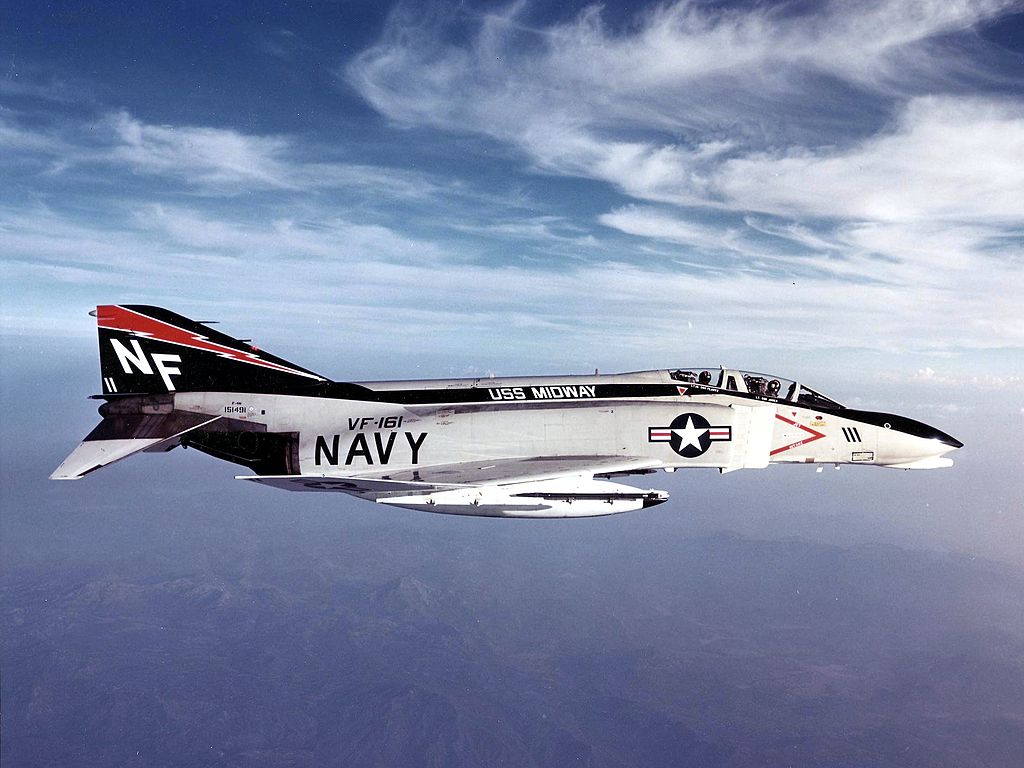“The F-4s got off to a horrid start when running into F-8s. Their reputation was dog-s**t,” Jerry B. “Devil” Houston, former F-8 driver
One of the most versatile fighters ever constructed was the McDonnell two-place, twinjet, all-weather F-4 Phantom II, which could reach high speeds of over twice the speed of sound. It served in the first line of more Western air forces than any other jet. The F-4 became the fastest, highest-flying, and longest-range fighter in the U.S. Navy only 31 months after its maiden flight. It first flew on May 27, 1958, and entered service in 1961.
In contrast to the F-4’s “all-weather interceptor” role, many of the Phantom’s early cruises were as paired squadrons with F-8 units, which were considered “day fighter” (or, in the F-8 pilots’ opinion, “fighter”) units, as explained by Peter E. Davies in his book Gray Ghosts, U.S. Navy and Marine Corps F-4 Phantoms. When the F-4 started to outnumber the Crusader and F-8 drivers began switching to the Phantom, the antagonism between the two communities grew more intense. Before making the switch, Jerry B. “Devil” Houston, who flew Crusaders with VF-11, summed up the situation as follows:
“The F-8 stole your heart from the get-go with its beauty and, for its time, power (God, an afterburner!), but it quickly earned an ensign-killer reputation, rightly or wrongly. In the long run, that reputation contributed greatly to fighter pilot development in the Navy: only the top ten percent of pilot graduates were even considered for the F-8 pipeline—the créme de la créme. And as luck would have it a damn solid base of mid-level stick-and-throttle talent groomed the hungry youngsters into frothing-at-the-mouth tacticians. Without experiencing it, anyone would be hard-pressed to understand the aura that surrounded that early F-8 Crusader community. An ensign in F-8s took no crap from a Lieutenant Commander who flew anything else. Period.
“Among that small, but growing privileged group, anyone in the first few squadrons knew damn near exactly where they stood in the overall tactics ladder. Killing, capability meant everything: King of the Mountain, in spades. Gunnery, tactics, gunnery, tactics, just enough intercept training to get you into the sky with another victim. F-8s didn’t bomb then—hell, the plane didn’t even have hardpoints on the wings. In other words, everything funneled the best pilots and the best airplanes through a narrow training spout, and out popped the world’s best fighter pilots. They all ate, breathed, thought, and dreamed about fighting airplanes. All the time.
“The F-4, on the other hand, was an ugly, two-seated, gas-hog monster that hit the Fleet with a bunch of F3H Demon interceptor pilots. Consequently, the F-4s got off to a horrid start when running into F-8s. Their reputation was dog-s**t, and the ex-Demon drivers didn’t have a clue about changing it. So they practiced intercepts, avoided tactics, and groomed follow-on clods in their own image. All the while that lovely top ten percent advantage kept aircrew infusing the Crusader community with superior talent, which rapidly molded into long-clawed killers. The rich got richer—and even richer. Better people, better training, frightful competition. Crusader pilots didn’t have to brag; they owned the sky. So it remained, until finally, an F-8 jock got into an F-4, screaming and dragging his heels all the way. The rest is history.”

F-8 pilots and tactics, which were initially transferred from their squadrons to the Phantom, undoubtedly sped up the development of F-4 ACM training. In 1971, Jerry Houston referred to his VF-51 as a “double-barreled Crusader squadron with an extra set of eyeballs in each plane” as the unit transitioned from the F-8J to the F-4B. However, the need for ACM was recognized far earlier than then, and it certainly predated the late 1960s initiatives that gave rise to the Top Gun ACM training project.
Photo by U.S. Navy

